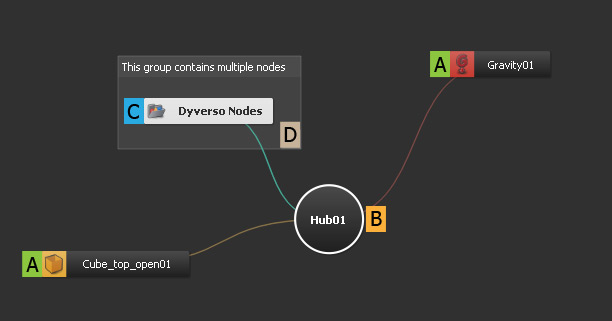Scene Element Nodes (A)
Every scene element is represented in RealFlow's “Relationship Editor” as an icon. The nodes in the “Relationship Editor”, the → viewport, and the → “Nodes” panel are synchronized. When a scene element is, for example, removed from the viewport it will also disappear from “Nodes” panel and the “Relationship Editor”.
There is also a very simple rule that is valid for all nodes in your project: if it is possible to link two nodes directly then they will be able to interact with each other.
Hubs (B)
When the first scene element is added RealFlow creates a “Hub”. All following nodes will be connected to this hub as well. A hub is a global connector: scene elements which are connected via a hub will be able to interact. If you do not want to create a default hub please disable
Tab menu > Add to Default Hub
New hubs can be created on demand to create groups of interaction: Tab menu > Add new Hub. A connection between a node and a hub is established in exactly the same way as node-node link:
- Place the mouse pointer over a node.
- Press the Cmd/Ctrl key while dragging a new line between the node and the hub.
Groups (C)
Groups will help to keep the “Relationship Editor” clear:
- Select the nodes you want to group.
- Right-click on one of the selected editor nodes and choose “Group”.
- The group can be expanded and collapsed with a double-click.
Notes (D)
Notes can are added from
Tab menu > Add New Note
Here are few basic things your should know about notes:
- To resize a note drag its lower right corner.
- When you click on the note's upper area it becomes editable.
- The note icon can be dragged to any place, but it will always remain in the background.
- If you want to change the note's text or icon colour right-click on its upper area, and choose the appropriate option from the menu.
